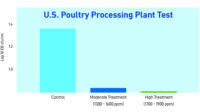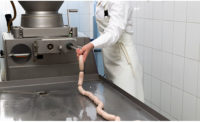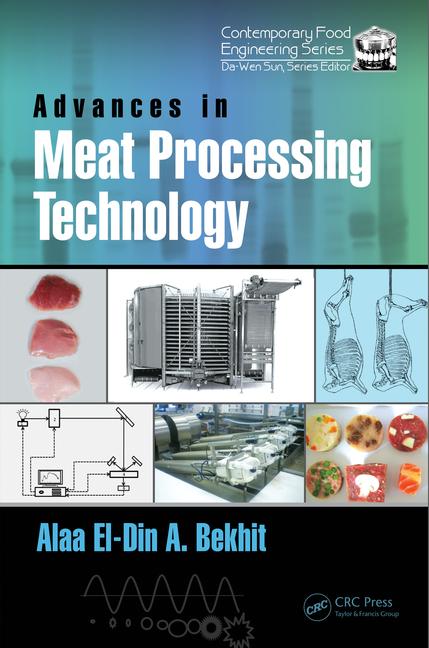Technology advances the cooking process

Oven, fryer and smokehouse equipment suppliers continually are improving the design to minimize the gap between what processors want their cooking equipment to do and what the machines are capable of doing. For example, in ovens, some of the more significant advancements are the ability to understand and better incorporate the four main components of thermal processing: dry-bulb temperature, wet-bulb temperature, air velocity and cooking time.
Although these thermal-processing components are not new concepts, advancements in managing the details of these four elements have helped improve processes and products through speeding up processing times, improving process efficiency and product quality, and advancing other aspects that impact yield, says Jeff Sindelar, extension meat specialist at the University of Wisconsin-Madison.
For example, as bigger ovens are made, processors have more capacity in plants, but the equipment still must maintain specific parameters of thermal processing, which becomes more challenging. In turn, continual improvements in design are being made.
“Every technology has challenges, but the challenges still lie in how to successfully implement those four elements of thermal processing and maximize the return from those,” Sindelar says. Computerization and advancements in software have boosted oven, fryer and smokehouse technology as well. Microprocessors allow for better regulation of processes to control the parameters. They also have the ability to make improvements and refinements. Processors can operate on a more precise level rather than a traditional, “in the ballpark” type, which has been more the standard historically, because of the limitations on some of the equipment, Sindelar says.
For fryers, automation is key. Technology allows for better control of the equipment, and the frying process is more streamlined, whether it is a frying breading or some type of prep before the frying.
For smokehouses, improved technology provides the ability to fine-tune processes, such as the design of the thermal processing with great precision. Processors are now able to control ovens more precisely, and smokehouses have more capabilities.
“We’re seeing more technology, such as RFID and wireless thermalcouples and thermometers that are being linked in, as well as software,” Sindelar says. “We’re seeing more advancements in pH probes and other tools that allow better monitoring of what is going on in the smokehouses — for not only improving quality but ensuring safety.”
Dan Weber of Weber Meats, Cuba City, Wis., agrees that the advantages of microprocessor technology to control from afar are vital. Today, technology allows smokehouses to be operated from the phone or home.
“With our busy time coming up with the holidays, we have to switch and flip loads,” he explains. “It’s really nice, instead of coming down here and just checking, I can just get on the computer and see that [a batch is] done, or I know when it’s going to be done — since sometimes that can be late at night.”
For smokehouses, many of the challenges are similar to those with ovens, including the battle to maintain dry-bulb temperature and air velocity. Although smokehouse design has come a long way, they are still susceptible to hot spots and cold spots, Weber says.
In smokehouses in particular, it’s very common to have cold spots and hot spots, Sindelar adds, because of lack of air flow, and the different variety of products and how that affects airflow patterns.
“You have a lot of opportunity for variability in cook processes, which can impact quality,” Sindelar explains. “It can economically impact the processor in the forms of variation of yields and higher than desirable losses. Smokehouse design is still a very, very critical component.”
Design of the cooking equipment greatly impacts processing. For example, ovens can include everything from smokehouses to bell cooking ovens, impingement cooking ovens, spiral cooking ovens and a continuous ovens.
“Certain types of design have definitely enhanced efficiency, speed and certain processes,” Sindelar says. As far as cleaning, certain ovens, by way of design, are easier to sanitize. For example, impingement ovens and spiral ovens have been designed to have certain components open in ways that improve sanitation. Some smokehouses have added automated sanitation systems as well, in which cleaning compounds are piped through, Sindelar says. Simplifying the cleaning process would be a huge advantage to processors, Weber adds.
The future of ovens, fryers and smokehouses includes the continually improvement of design and improvement in technology such as software and hardware to control the equipment. Cooking equipment operators can make an impact too.
“There is a lot of future opportunity in operator knowledge to better understand how those oven fryers and smokehouses are operating; what impacts certain thermal-processing steps or certain components of thermal processing have on product quality and yield; and how to adjust those oven, fryers and smokehouses to improve quality and economic elements of the process,” Sindelar says.
Looking for a reprint of this article?
From high-res PDFs to custom plaques, order your copy today!










